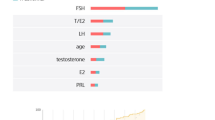Abstract
Traditional serum hormone testing in the evaluation of male infertility consists of testosterone, follicle-stimulating hormone, luteinizing hormone, and estradiol. Based on these values, medical therapy is often initiated in an attempt to increase intratesticular testosterone levels and, in turn, promote spermatogenesis. While this hormone panel provides serum testosterone levels, it does not evaluate intratesticular testosterone, obviously an important factor that is critical for spermatogenesis. 17-hydroxyprogesterone (17-OHP) is an intermediate in the steroidal pathway of cholesterol to testosterone conversion that has recently demonstrated promise as an accurate serum biomarker for intratesticular testosterone. At present, 17-OHP has not been widely adopted as a clinical tool in the evaluation of male infertility, which likely stems, in part, from a lack of concrete indications for its use. In this review, we present five commonly encountered scenarios of male infertility where the utilization of 17-OHP has aided in the management and provided a more personalized approach to treatment.
This is a preview of subscription content, access via your institution
Access options
Subscribe to this journal
Receive 12 print issues and online access
$259.00 per year
only $21.58 per issue
Buy this article
- Purchase on SpringerLink
- Instant access to full article PDF
Prices may be subject to local taxes which are calculated during checkout
Similar content being viewed by others
References
Jin JM, Yang WX. Molecular regulation of hypothalamus-pituitary-gonads axis in males. Gene. 2014;551:15–25.
Isidori AM, Giannetta E, Lenzi A. Male hypogonadism. Pituitary. 2008;11:171–80.
Wang RS, Yeh S, Tzeng CR, Chang C. Androgen receptor roles in spermatogenesis and fertility: lessons from testicular cell-specific androgen receptor knockout mice. Endocr Rev. 2009;30:119–32.
Kumar TR, Wang Y, Lu N, Matzuk MM. Follicle stimulating hormone is required for ovarian follicle maturation but not male fertility. Nat Genet. 1997;15:201–4.
Kumar TR. Functional analysis of LHbeta knockout mice. Mol Cell Endocrinol. 2007;269:81–4.
Schlegel PN, Sigman M, Collura B, De Jonge CJ, Eisenberg ML, Lamb DJ, et al. Diagnosis and treatment of infertility in men: AUA/ASRM guideline part I. Fertil Steril. 2021;115:54–61.
Walker WH. Testosterone signaling and the regulation of spermatogenesis. Spermatogenesis. 2011;1:116–20.
Coviello AD, Bremner WJ, Matsumoto AM, Herbst KL, Amory JK, Anawalt BD, et al. Intratesticular testosterone concentrations comparable with serum levels are not sufficient to maintain normal sperm production in men receiving a hormonal contraceptive regimen. J Androl. 2004;25:931–8.
Hsieh TC, Pastuszak AW, Hwang K, Lipshultz LI. Concomitant intramuscular human chorionic gonadotropin preserves spermatogenesis in men undergoing testosterone replacement therapy. J Urol. 2013;189:647–50.
White PC. Neonatal screening for congenital adrenal hyperplasia. Nat Rev Endocrinol. 2009;5:490–8.
Lima TFN, Patel P, Blachman-Braun R, Madhusoodanan V, Ramasamy R. Serum 17-hydroxyprogesterone is a potential biomarker for evaluating intratesticular testosterone. J Urol. 2020;204:551–6.
Amory JK, Coviello AD, Page ST, Anawalt BD, Matsumoto AM, Bremner WJ. Serum 17-hydroxyprogesterone strongly correlates with intratesticular testosterone in gonadotropin-suppressed normal men receiving various dosages of human chorionic gonadotropin. Fertil Steril. 2008;89:380–6.
Lee JA, Ramasamy R. Indications for the use of human chorionic gonadotropic hormone for the management of infertility in hypogonadal men. Transl Androl Urol. 2018;7:S348–S52.
Lima TFN, Rakitina E, Blachman-Braun R, Ramasamy R. Evaluation of a serum 17-hydroxyprogesterone as a predictor of semen parameter improvement in men undergoing medical treatment for infertility. Can Urol Assoc J. 2021;15:E340–E5.
Mulhall JP, Trost LW, Brannigan RE, Kurtz EG, Redmon JB, Chiles KA, et al. Evaluation and management of testosterone deficiency: AUA guideline. J Urol. 2018;200:423–32.
Ventimiglia E, Ippolito S, Capogrosso P, Pederzoli F, Cazzaniga W, Boeri L, et al. Primary, secondary and compensated hypogonadism: a novel risk stratification for infertile men. Andrology. 2017;5:505–10.
Shabsigh A, Kang Y, Shabsign R, Gonzalez M, Liberson G, Fisch H, et al. Clomiphene citrate effects on testosterone/estrogen ratio in male hypogonadism. J Sex Med. 2005;2:716–21.
Messinis IE, Templeton A. Blockage of the positive feedback effect of oestradiol during prolonged administration of clomiphene citrate to normal women. Clin Endocrinol. 1988;29:509–16.
McBride JA, Carson CC, Coward RM. Diagnosis and management of testosterone deficiency. Asian J Androl. 2015;17:177–86.
Lazarou S, Reyes-Vallejo L, Morgentaler A. Wide variability in laboratory reference values for serum testosterone. J Sex Med. 2006;3:1085–9.
Paduch DA, Brannigan RE, Fuchs EF, Kim ED, Marmar JL, Sandlow JI. The laboratory diagnosis of testosterone deficiency. Urology. 2014;83:980–8.
Le M, Flores D, May D, Gourley E, Nangia AK. Current practices of measuring and reference range reporting of free and total testosterone in the United States. J Urol. 2016;195:1556–61.
Pavlovich CP, King P, Goldstein M, Schlegel PN. Evidence of a treatable endocrinopathy in infertile men. J Urol. 2001;165:837–41.
Leavy M, Trottmann M, Liedl B, Reese S, Stief C, Freitag B, et al. Effects of elevated beta-estradiol levels on the functional morphology of the testis - new insights. Sci Rep. 2017;7:39931.
Author information
Authors and Affiliations
Contributions
Conceptualization: RoRe, MP, RR. Data curation: RoRe, MP, RR. Formal analysis: n/a. Funding acquisition: RR. Investigation: RoRe, MM. Methodology: RoRe, MP, MM, RR. Project administration: RR, MP. Resources: RR. Software: n/a. Supervision: RR. Validation: MP. Visualization: RoRe. Writing—original draft: RoRe, MM, MP. Writing—review & editing: MP, RR.
Corresponding author
Ethics declarations
Competing interests
The authors declare no competing interests.
Ethical approval
This study is a clinical case review and did not require patient contact. All writing and crediting practices were conducted to the standard of Journal Article Reporting Standards (JARS).
Additional information
Publisher’s note Springer Nature remains neutral with regard to jurisdictional claims in published maps and institutional affiliations.
Rights and permissions
About this article
Cite this article
Reddy, R., Mason, M., Patel, M. et al. Clinical utility of serum 17-hydroxyprogesterone as a marker for medical therapy for male infertility: recommendations based on clinical scenarios. Int J Impot Res 35, 79–81 (2023). https://doi.org/10.1038/s41443-022-00541-z
Received:
Revised:
Accepted:
Published:
Issue date:
DOI: https://doi.org/10.1038/s41443-022-00541-z
This article is cited by
-
Testosterone replacement therapy and spermatogenesis in reproductive age men
Nature Reviews Urology (2025)



